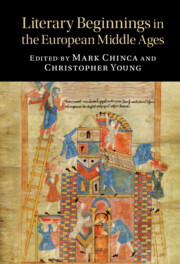Book contents
- Literary Beginnings in the European Middle Ages
- Cambridge Studies in Medieval Literature
- Literary Beginnings in the European Middle Ages
- Copyright page
- Contents
- Contributors
- Acknowledgments
- Foreword
- Chapter 1 Introduction
- Chapter 2 Scandinavia
- Chapter 3 Irish and Welsh
- Chapter 4 English
- Chapter 5 Spain
- Chapter 6 French
- Chapter 7 Dutch
- Chapter 8 Occitan
- Chapter 9 German
- Chapter 10 Italian
- Chapter 11 Czech and Croatian
- Chapter 12 Greek
- Chapter 13 East Slavonic
- Afterword
- Index
- Cambridge Studies in Medieval Literature
Chapter 2 - Scandinavia
Published online by Cambridge University Press: 11 August 2022
- Literary Beginnings in the European Middle Ages
- Cambridge Studies in Medieval Literature
- Literary Beginnings in the European Middle Ages
- Copyright page
- Contents
- Contributors
- Acknowledgments
- Foreword
- Chapter 1 Introduction
- Chapter 2 Scandinavia
- Chapter 3 Irish and Welsh
- Chapter 4 English
- Chapter 5 Spain
- Chapter 6 French
- Chapter 7 Dutch
- Chapter 8 Occitan
- Chapter 9 German
- Chapter 10 Italian
- Chapter 11 Czech and Croatian
- Chapter 12 Greek
- Chapter 13 East Slavonic
- Afterword
- Index
- Cambridge Studies in Medieval Literature
Summary
In Iceland, as on the Continent, the fifty years on either side of 1200 witnessed a burst of literary production in the vernacular. The new medium of the book, with its state-of-the-art technological infrastructure and storage potential, had arrived. Norse prose texts were composed and compiled in emulation of or in rivalry with Latin and European vernacular models. Elite channels funnelled Latin learning throughout the country, invigorating and fertilizing its famed indigenous traditions. In the centuries that followed, some literary works were kept, some discarded, some were remodelled to suit shifting tastes. Textual collections reveal individual strategies of acquisition, classification, and censorship. Sociologists speak of the dynamics of hip-hop or jazz in terms of African and European counterflows, minglings, intertwinings, see-sawings, stigmergies, feedback loops, co-optations, hybridizations, and other vertiginous to-ings and fro-ings. In medieval Scandinavia as elsewhere, the exotic and different exerted an attraction, with new literary forms slowly obsoleting the old. The literary culture of medieval Scandinavia achieved its shape under the influence of European models, but was at the same time conditioned by local economic, social, and political arrangements.
- Type
- Chapter
- Information
- Literary Beginnings in the European Middle Ages , pp. 23 - 44Publisher: Cambridge University PressPrint publication year: 2022

